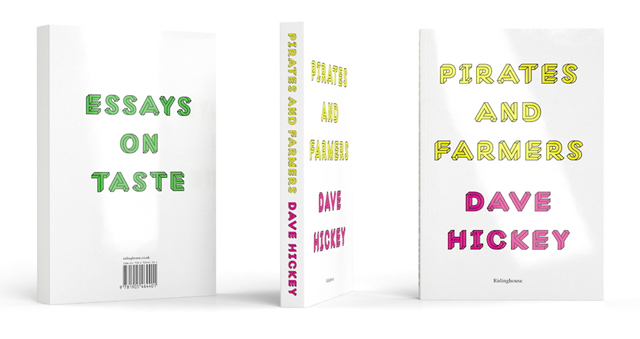February 19, 2014
Pirates and Farmers

I'm reading Dave Hickey's Pirates and Farmers, delightful.
Hickey published another collection of essays, a form in which he excels. It's classic Dave Hickey, sentences and paragraphs loaded to the hilt with concepts and images. One could be pardoned for anticipating a hard slog of a read, but his stream of concepts/images gnarl and interlock like mangrove roots in the river delta of our 55 or so year old postmodern epoch. The mangrove trees rise in groves of ideas in his essays, ideas that are actually the recovery of common sense, the awareness of which is rare in the saline rich, low oxygen muck and silt of this moment in art history. And because reading Hickey is such delightful tussle in the thicket and tangle of his concept-images results in the crystallization of simple common sense, one doesn't emerge from his work over laden and encumbered. For all of his dense pack style, the take away from each of his essays are light and airy and all the more important because of this.
Common sense. He reminds us of what we already know but have yet forgotten in our humid, evaporating delta. I can relate to his writing because Hickey teaches us about art much as I used to teach architectural design: to make my students aware of knowledge they already possess. In the curriculum of third year architecture, one quarter is devoted to long span structures. To illustrate cantilevers and overturning moments, I would ask the student to hold their arm out parallel to the floor. Then I apply downward pressure on their hand, and talk them through methods of arresting the force, to render the dynamic, static: muscles and tendons stiffen the ball and socket of the shoulder, to brace yourself with the other arm, to lock the force into your body by grounding the elbow to the hip. Hickey reminds us what we already know, of how we formulate taste, the difference between intrinsic and extrinsic value, how markets form, what formalism really is, how pervasive all this and more are in our lives.
To illustrate, here is the first paragraph in the introduction:There are always absolutes. There are pirates and there are farmers. We are all one or the other, but even these genetic empires are scattered with the protean archipelagos of taste. We want what we want, but like obsessive serial killers, we want it exactly the way we want it. We want the corpse wearing Mama's lipstick, os,a long with aroma, taste is the oldest most precedent sense. Our lizard brains were tasting and smelling things long before we started worshipping them. So I should start with Andy Warhol, because his first masterpieces articulate the distinction between taste and desire.
And here is a list of 14 concepts -images within:
1. Absolutes. G-d. The horizon. Life circumscribed.
2. Pirates and Farmers. Hunter-gatherers. Seizing and cultivating.
3. One or the Other. Manichaean. Dualism. Polarity. The necessity and consequence of choice.
4. Genetic Empires. Darwin. Colonialism. Eco-systems. Double helix. Succession.
5. Archipelagos of Taste. The internet. Solzhenitsyn (alright, I'm reading the Gulag Arcipeago at the moment).
6. We want what we want Desire. All too human.
7. Obsessive Serial Killers. (Their faces arise in my mind, but I abhor them too much to trouble with their names. )
8. The Corpse. Dust to dust. Medieval Spanish crucifixes.
9. Mama's Lipstick. Hitchcock's Psycho. The Machurian Candidate.
10. Aroma, Taste. Cravings for food. Childhood.
11. Lizard Brains. Darwin again. Fight or flight. Dinosaurs.
12. Long before we started worshipping them. Millennia. The dawn of mankind.
13. Andy Warhol. That wig. Zen evasion. Any silkscreen.
14. Taste and desire. The role of the amature. Communities of taste.
Leave a comment